With the discovery of a mineral water well in 1571, Harrogate became England's first spa. Yet in the middle of the 19th century (by which time it had many competitors) it was not what might be called a
typical English spa. For, as Malcolm Neesam points out,
The majority of British spas had, with varying degrees of success, modelled their developments on Bath, with the construction of baths, pump rooms, assembly rooms, formal social structures, ample housing development, and speculative freedom. By the opening of the railway era, tastes had changed, and the new seaside resorts proved a severe challenge to the traditional spas. Harrogate, however, had never been a traditional spa, and right up to the 1841 [Harrogate Improvement] Act, it remained undeveloped, semi-rural and informal. 1
This situation changed rapidly after the Act. Not only the town as a whole, but also its mineral water facilities, developed considerably between 1841 and the incorporation of Harrogate in 1884. Complementing a number of privately owned bathing and mineral water establishments, the Improvement Commissioners had opened their own Victoria Baths in 1871. But success brought its own problems, not the least of which was maintaining a lead over the competition.
In 1887, the Corporation sent its Surveyor across the Channel to find out what facilities were being provided by some of the major spas in Europe.2 His findings prompted the councillors to upgrade their own provision and they initially intended to extend and improve the Victoria Baths. In the event, however, they decided to build a completely new baths establishment, to be called the Royal Baths. To find an appropriate design they held an international competition which was adjudicated by George Corson, a well-known Leeds architect.
Twenty-six sets of plans were submitted, and the winners were Messrs Baggallay and Bristowe of London.3 Although some of the proposed features, such as the domed pump room, were later cut in order to keep down the cost, what remained still included a glazed winter garden, domed entrance hall, and multifarious treatment rooms designed to make the baths the finest hydrotherapy centre in Europe.
The new baths were to be built on a site still occupied by existing baths on the Corporation's recently purchased Montpellier Estate. The Montpellier Baths had for some time included a suite of Turkish baths which the Corporation now found itself operating—'First class Turkish baths for gentlemen: 2/6.' 4
But whether or not this was a significant factor in making the decision to include Turkish baths in the new building is not known. The Corporation's other establishment, the Victoria Baths, had none, although by this time there were at least half-a-dozen privately owned hydropathic establishments in the town which had Turkish baths, and these were open to the general public as well as to their own residents.
In 1894, tenders for the construction of the baths were accepted. Clearance of the site began in February, and the foundation stone was laid by the Mayor, Charles Fortune, on 25 April with some considerable ceremony.
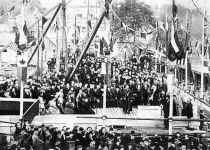
With an eye to retaining some of their existing clientele during the building of the new baths, the Corporation demolished the Montpellier Baths in two stages, the original Turkish baths remaining in operation until the new ones were ready for use.5 The Royal Baths were completed at a cost of around £120,000 and officially opened by HRH the Duke of Cambridge on 23 July 1897.
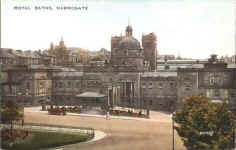
The exterior of the building, said Thorpe’s new guide to Harrogate a decade later, ‘presents an architectural pile of solid but artistic proportions, which reveals fresh dignity at every point.’ 6
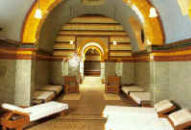
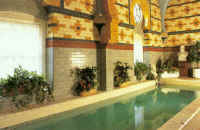
View of the three hot rooms The cold plunge pool
While just prior to the opening, Pike’s illustrated account of Harrogate noted that the bathrooms in the Turkish baths 'are of solid glazed brickwork in beautiful tints and patterns' and that the floors were laid in oak parquet or 'in marble mosaic specially designed…' 7
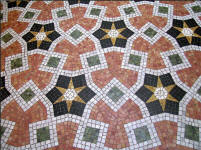
Part of a mosaic floor
Shortly after the baths opened, Cyril Baggallay (of Messrs Baggallay and Bristowe) spoke of his company's design in a lecture on 15 September at the Sanitary Congress, Leeds. His description of the magnificent Turkish baths was a masterpiece of understatement:
The south-east corner of the site is occupied by a Turkish bath, about which I do not know that there is much I could say to interest you, unless I were to describe the oriental appointments and decoration, which are rather more luxurious than is quite usual. It accommodates about twenty-two persons, and care has been taken to provide a good supply of fresh air, which is heated in a Crumblehulme’s furnace. There is also a good cold plunge. The hot rooms, lavatories, and so on, are lined with coloured glazed bricks. On the south-west is a series of special rooms, an inhalation room where people can sit about and read, or amuse themselves while inhaling the vapour, produced by a hot, mineral water fountain; a pulverisation room, fitted with little marble tables, on which are delicate instruments for spraying the eyes, nostrils, throat and ears; and a suite of massage rooms. 8
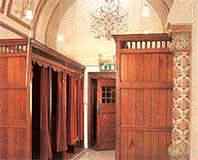
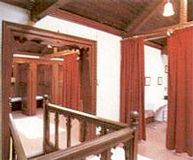
Changing cubicles
Massage rooms
In addition to the Turkish baths, more than a dozen other types of bath, douche, or treatment were available, together with the opportunity to drink a variety of different types of mineral water. The baths opened from 7.00 am till 8.00 pm on weekdays in the summer and for a shorter period in the winter.
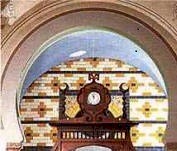
Clock over entrance to the pool
There were special days for women bathers and, unlike many Turkish baths at the turn of the century, they were also open on Sunday mornings. From November to May, a Turkish bath cost 3/- (6d more than at the old Montpellier Baths) and 3/6 from June to October. A massage cost 2/- for the first fifteen minutes, and 1/6 for each additional quarter of an hour.
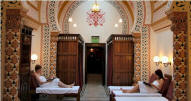
Women's day in the cooling-room
The three hot rooms were maintained at temperatures of 120°, 180°, and 210° Fahrenheit. The general procedure for taking a Turkish bath at the Royal Baths was little different from that in any other first class establishment, though there was rather more personal attention than one would expect to receive anywhere today. If, for example, it was wet outside, it was considered advisable after removing one's shoes 'to ask the attendant to put them in a warm place so that they may be dry and comfortable when put on again.' 9
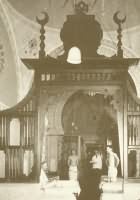
The cooling-room of yesteryear
After an initial shower, the bather selected a seat in the first hot room, 'upon which the attendant will spread his towel'. And while lying down in the hottest room,
The attendant will bring a tumblerful of cold water; if not, it should be asked for, or taken from the tap. If there is any fulness in the head, or faintness, the bathman should be summoned by clapping the hands. If the feet are cold, the bathman will douche them with hot water, and some bathers may with advantage have a hot needle bath; indeed, for any disagreeable symptoms the bathman should be consulted, and from his immense experience he will probably know the appropriate remedy. 10
In due course, the bather was summoned to the shampooing room where 'he reclines on a marble slab, upon which the bathman places the towel.' Towels also cover specially shaped wooden rests to support the bather's head and ankles.
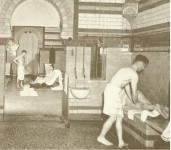
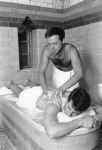
Two generations
of shampooers
To the uninitiated, the Turkish bath often seems a strange ritual to be endured rather than enjoyed. So, in descriptions of a first visit, the whole bathing process has frequently been seen as a target for gentle humour. Even Harrogate's famous Royal Baths were not exempt from this treatment and in 1933, when admission still cost only 4/-, an article called A Yorkshireman takes his first Turkish bath appeared in a local paper under the nom-de-plume CHRONICLER,
and later reprinted as an 8 page booklet "By C.E.T.".
 Over two broadsheet columns in length, and rather laboured by today's standards, the adventures and misunderstandings of the novice were described, from the bather's sitting fully dressed in his changing cubicle wondering why he hadn't started to sweat, through a brief stay in the steam room, to his turn with the shampooer.
Over two broadsheet columns in length, and rather laboured by today's standards, the adventures and misunderstandings of the novice were described, from the bather's sitting fully dressed in his changing cubicle wondering why he hadn't started to sweat, through a brief stay in the steam room, to his turn with the shampooer.
So, first, he warmed t 'slab wi' a bucket of 'ot water. Then 'e says, "Sit dahn here, sir." So Ah sat dahn. An' 'e got hold of my arms—first one, then t' other—an' rubbed them up an' dahn. Then he did t' same wi' my legs. Then 'e says "Lie on yer back, please." An' he started an' pummelled me wi' his fingers an' thumbs, right from my neck dahn ter my feet. Then he says "Turn over, please." An' 'e'd got mi 'ed in a sort o' wooden block, which mi neck just fitted in. An' Ah began ti think of t' guillotine. But t' shampooer said "You're all right," an' 'e 'elped me to turn over, so as Ah shouldn't slip off t' slab like. The 'e started pummellin' and rubbin' me again, right from mi neck to mi feet. "My word," he says, "it's coming out of you."
Then 'e put 'is 'and dahn mi spine an' started hammerin' me. "There," he says, "that rouses your liver." Then 'e got a sort of loofah scrubbing brush, soaped it well wi some pine soap (it did smell grand), an' 'e scrubbed me dahn proper—it wor grand. Then 'e says, "Sit up, please." But 'e 'ad to 'elp me, for Ah wor covered wi soap. Then 'e scrubbed me all down mi front from top ti toe, an' got a bucket of warm watter an' threw it over me—a reg'lar dowsin'. By, Ah did feel fit after it! 11
And so on, through the showers and cooling-room, to a final summing up: 'But Ah wor well satisfied wi' my "turkish". And, my word, you do feel grand after it!'
Could CHRONICLER, perhaps, have been in the employ of the Harrogate publicity department?
In 1969, arising from more modern approaches to treatment and the advent of the National Health Service which built its own more up-to-date facilities, the treatment and consulting rooms closed and became the Assembly Rooms. 12
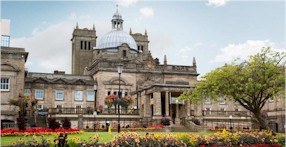
Until very recently, the Turkish baths alone remained as a reminder of past therapeutic glories. Now, however, an attempt is being made to recover some of Harrogate's popularity as a spa, and Harrogate water is again to be bottled for sale.
The first stage of the refurbishment of the Royal Baths was completed on 4 March 2002 and included creating a new entrance to the Turkish baths off Parliament Street, adding seven treatment rooms, a spa room and a lift to the first floor. A covered atrium was also created from a previously unused courtyard which now provides an area where bathers can obtain light refreshments. It also provides a link between the treatment rooms, which can now be accessed without disturbing people using the Turkish baths.
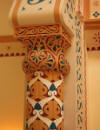
The second stage of the refurbishment programme, which involved the restoration, to its original state of decoration, of the interior of the Turkish bath area itself, was completed during the latter part of 2003 and the first half of 2004.













 Over two broadsheet columns in length, and rather laboured by today's standards, the adventures and misunderstandings of the novice were described, from the bather's sitting fully dressed in his changing cubicle wondering why he hadn't started to sweat, through a brief stay in the steam room, to his turn with the shampooer.
Over two broadsheet columns in length, and rather laboured by today's standards, the adventures and misunderstandings of the novice were described, from the bather's sitting fully dressed in his changing cubicle wondering why he hadn't started to sweat, through a brief stay in the steam room, to his turn with the shampooer.
